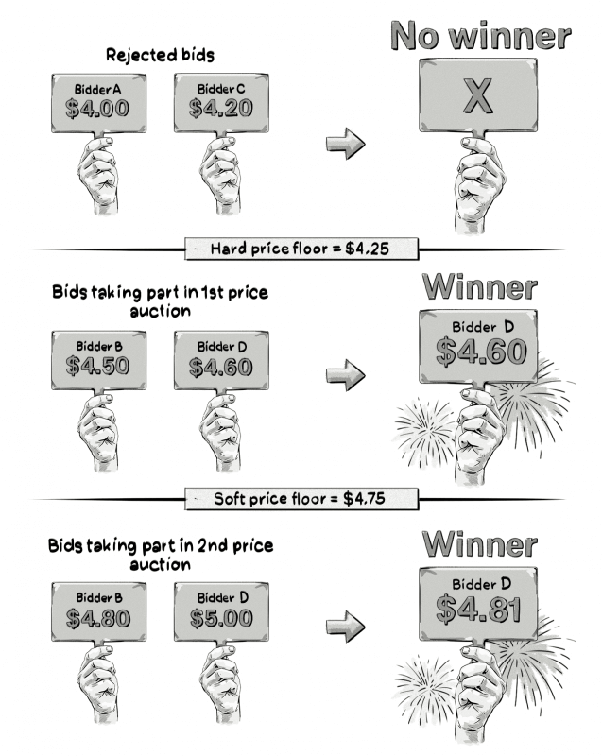Last updated on July 21st, 2022 at 12:15 pm
Understanding website monetization is an art, science, and logic mixed into one. As I slowly understand the dynamics of media buying, it seems that monetization is more than placing the ads at the right position and making users click. It’s more about ensuring that the ecosystem wins where the advertiser makes more profit from every impression which is delivered to the publisher website. The ad network should continue to have these advertisers on-board since they make money from them and as a whole, the entire ecosystem should win. Once you get this right, you will understand the underlying principle of media buying and media selling. To play fair, and to play for a long tenure, everyone should be winning and that should be your main goal. While you still can exploit the loopholes to make better revenue on your part. In this article, we will discuss a bit about media buying and they go ahead with first price auction and second price auction and shall discuss how publishers can make use of these to increase their overall ad revenue.
Publishergrowth: The Revenue Acceleration Platform for Publishers
Blognife is elated to announce the launch of Publisher Growth- a community of publishers that helps you actively accelerate your revenue. This platform assists publishers in growing their traffic and revenue. As publishers, you can share and read reviews of ad networks and hosting companies. You can connect with other publishers to build links for growth and monetization hacks and more. This platform will help you stay up to date with the advertising and publisher ecosystem.

Features:
Understanding Media Buying
In order to understand the sell-side better, you should also be able to understand the buy-side. This will give you a more vivid picture of the entire ecosystem and thus your strategies of monetization, content creation or content planning will be more robust in the long run. To start off, almost 80% of your revenue is brought by less than 20% of the impressions. This essentially means that there is a huge gap in inventory buying, rates, quality conversions and more. If you are using AdSense revenue profile or have used the AdSense lab tools, you can have a fair idea of this. Take a look here…

This means, essentially, buyings are paying premium rates for some impressions and a fair volume of impressions are taken at flat rates. However, almost most of the time these pricings and optimizations are determined by Google’s algorithms (smart pricing) or other techniques that define the CPC or CPM on individual websites. So, based on the traffic, conversions and other parameters, these rates change!
Understanding First Price Auction
In a real time bidding environment, major transactions take place in CPM basis where buyers bid on your ad spaces at specific rates. The same buyer may be bidding at your ad space through different DSPs and Exchanges. These bids essentially vary and depend on factors like advertiser’s competitors who are bidding on the same ad space. Higher the competition, higher should be the bid so that the winning impression is credited to the buyer. In a first price auction mechanics the buyer has to pay the actual amount which he or she is bidding on the impression if the impression is won by him. So, if there are 3 advertisers who are bidding at $1.44. $1.23, and $2.1 for a particular impression, the one who made the bid of $2.1 actually wins the auction and pays the publisher the rate of $2.1 (obviously after the network cut). This is defined as first price auction where the advertiser or the marketer ends up paying what he or she has actually bid on the impression. However, this might result in bit higher price variation as the buyers have limited knowledge of the quality of the impression and other first hand information which makes it possible for them to predict the exact worth of every impression. In order to overcome this fallacy, second price auction has emerged.
Understanding Second Price Auction
Second price auction is declared by many exchanges like Google ADX and others to protect the interest of the buyers and give them the flexibility of bidding at rates they truly believe but at the same time doing a justice to their advertising spend. In a second price auction environment, the buyer will pay 1 cent more than the second highest bid price which is auctioned and not his or her actual bid. Assume a case where 4 advertisers have bid for the same impression which and their bids are $1.5, $2.2, $3.17 and $1.88. Here, the buyer who wins the auction has made a bid of $3.17, however, the second highest bid is $2.2. So, essentially, if the buyer had made a bid of $2.21, he would have won the auction at that price and would have made a saving of 96 cents. Ideally, this is what happens in a second price auction where the buyer actually ends up paying $2.21 and not $3.17.
First Price vs Second Price Auction: A Comparison
Most of the advertisers don’t have much idea of the first price and second price auction mechanics. Also, many DSPs don’t share with the advertisers whether they are running on first price or second price auctions. However, it is important for both the advertisers and publishers to understand these mechanisms since using price floor setups, publishers can truly change a second price auction to a first price auction thereby making more revenue for every impression which is served on the website.
How Price Floors turn Second Price Auction to First Price?
Setting up price floors essentially changes a second price auction to a first price auction and we use this technique to substantially increase the overall revenue for publishers. While this setup requires a number of tweaking to finally achieve an optional revenue, this is effective for quality sites which generates substantial revenue. Now that you know how first price auction and second price auction works, assume a situation where publishers are setting price floors. Only if the advertiser pays more than a fixed CPM, the ads will be displayed, else it will go to another network. This essentially creates a threshold (a price floor) and forces the advertiser to pay the actual bid which they made on the impression instead of second price auctions. Assume a situation where there are three advertisers who have made the following bids respectively- $3.5, $2.1 and $1.57. The publisher has set a price floor of $3 in this ad server, and thus the advertiser is bound to pay $3.5 due to the price floor threshold which is imposed on the publisher website. This increases the overall revenue which otherwise would have been only $2.11 for the publisher (in a second price auction environment). Thus optimizing and setting up floor prices effectively increase the overall ad revenue for the publisher.
Using an Ad Server Like DFP to Increase your Overall Revenue
Gone are the days where publishers were serving a single javascript tag from one individual network. While you may still do that at lower page level thresholds, this doesn’t make sense on a higher pageview volume. Using multiple line items across a network of ad networks, exchanges or SSPs ensure that you’re receiving the highest rates. An advertiser bidding at $3 CPM for an impression might not make the same bid to the same visitor over again. So, you can use ad servers like DFP which caps the impression to one visitor at a time and make it passback to another ad network when the same visitor visits another ad network. Also, you can play around with various line items and optimize your ad setup for higher bids from DFP first look and dynamic allocation. Do note that these exchanges will try to buy your impressions at lower rates, and you should be trying to increase the worth of your impression by adding more networks, SSPs, and Exchanges. This will make advertisers pay more who are genuinely interested in your impressions.
The Takeaway for Publishers
With more technology coming in between the publisher and advertiser (Ad Exchanges, DSPs, SSPs, and ad optimization networks) it is becoming a tug of war to serve impressions which are valued most to the advertisers. These SSPs and DSPs provides additional information about the visitors which they collect and makes it more important in the eyes of the advertisers, thus enabling greater revenue per impression. As a publisher, you should be able to understand the different layers of ad serving and use and effective ad setup to increase your overall ad revenue. If you’ve more than 300,000 page views a month and want us to help you increase your ad revenue, do get in touch with us! We hope this article on First price auction vs second price auction was indeed helpful.
Our Recommended Tools for Publishers:
- Best AdSense Alternative- Setupad, Ezoic
- Push Notification Network- iZooto, Unative,
- Best Contextual Ad Network- Media.net (Extra 10% for 3 months)
- Native Ad Network- Mgid
- Popup Ad Network- Exoclick, Propeller Ads
- Best Web Hosting- Bluehost, Hostgator, Stablehost, WPEngine
- Blogging Tools- OptinMonster, Astra, Teachable,

I and my team research various ad networks and can help you increase your overall ad revenue; so you could rake in more greenbacks with the best monetization platforms. Tap into the power of the online publishing business with me. I am just a mail away, so reach out to me if you want to scale up your website revenue. mail: [email protected]



1 thought on “First Price vs Second Price Auction”